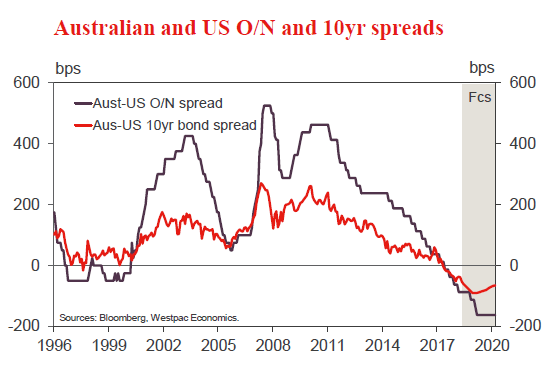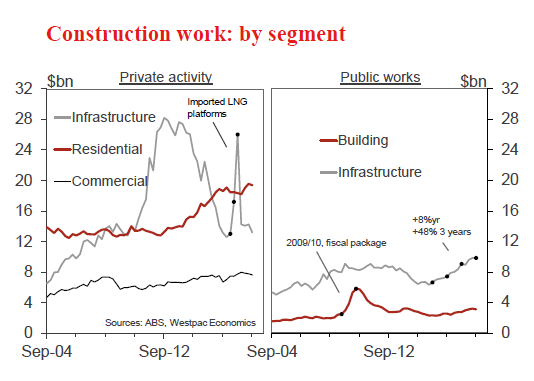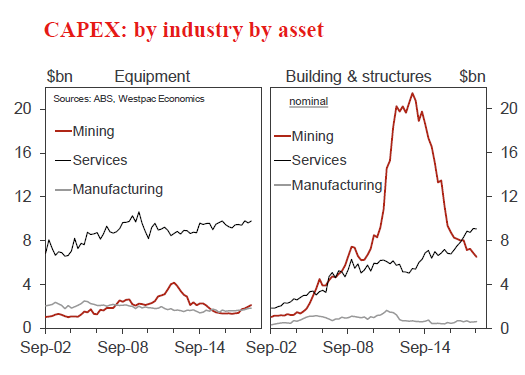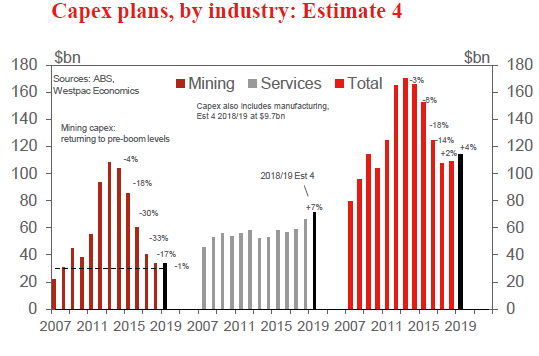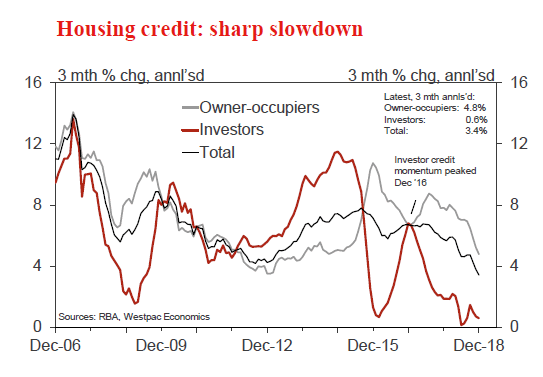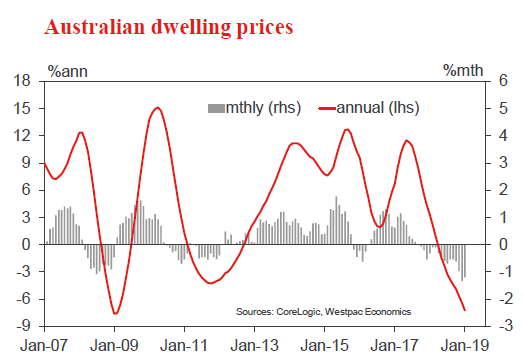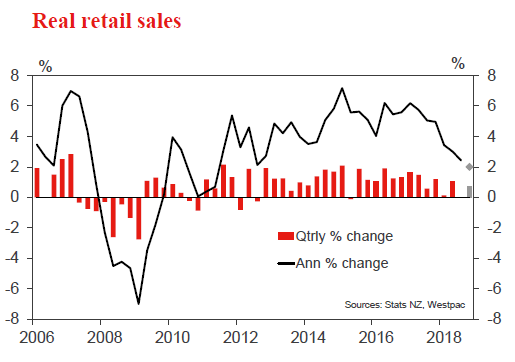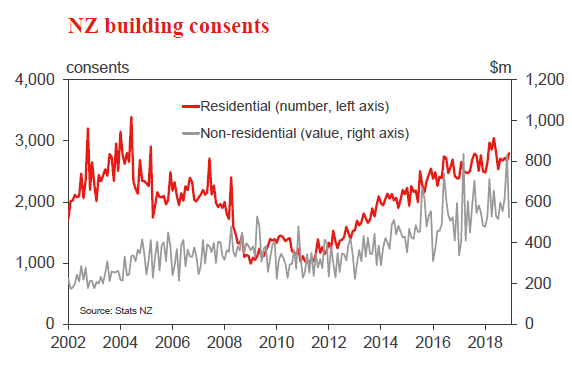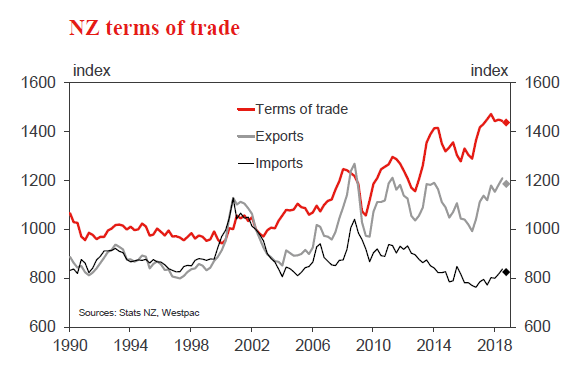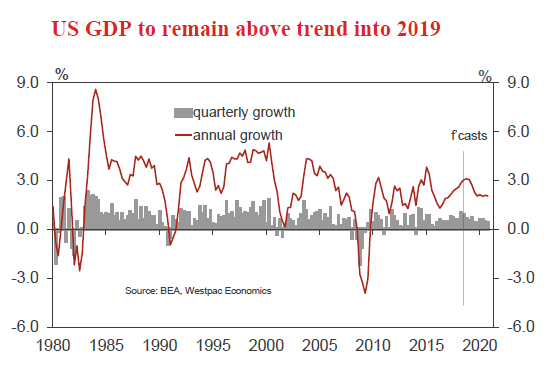Week beginning 25 February 2019
- Westpac expects the RBA to cut the Cash Rate 25bps in August and November.
- Australia: dwelling prices, capex survey, construction work, credit.
- NZ: retail trade, business confidence, building consents, terms of trade.
- China: NBS PMI’s.
- Europe: CPI, EC business surveys.
- US: GDP, PCE deflator, Fed Chair Powell semi-annual testimony.
- Key economic & financial forecasts.
Information contained in this report current as at 22 February 2019.
Westpac Expects the RBA to Cut the Cash Rate by 25bps in August and November
Westpac now expects the Reserve Bank to cut the cash rate by 25bps in both August and November this year.
We have revised down our GDP growth forecasts for 2019 and 2020 from 2.6% to 2.2%. With the slower growth profile we now expect to see the unemployment rate lift to 5.5% by late 2019. That makes a strong case for official rate cuts to cushion the downturn and, in turn, meet the RBA’s medium term objectives.
The Reserve Bank recently revised down its growth forecasts for 2019 and 2020 from 3.25% and 3.0% to 3.0% and 2.75% respectively. It also cut its estimate for 2018 from 3.5% to 2.75%.
Momentum in 2018 slowed dramatically through the year. The annualised growth rate in the first half was 4% whereas in the second half we estimate that the pace slowed to 1.5%.
Moving from a 1.5% pace to a 3% pace in 2019 seems to be a very large stretch.
Westpac’s growth forecast in 2019 and 2020 has been a much weaker 2.6% in each year but even that number now appears too high.
Our new forecast for GDP growth in 2019 and 2020 is 2.2%. In particular, we have been expecting only a modest impact on consumer spending from the likely negative wealth effect associated with falling house prices in Sydney and Melbourne.
Our growth forecasts have assumed a lift in the savings rate across 2019 from 2.4% to 2.9%. That would be consistent with consumption growth of 2.4%. Note that we expect momentum in consumption growth in the second half of 2018 to be closer to 1.5%.
A more reasonable assessment of the lift in the savings rate in 2019 is from 2.4% to 3.5% with a lift towards 5.0% expected in 2020. Those savings rates imply consumer spending growth around 2%.
That lift assumes that house prices in Sydney and Melbourne will continue to fall through 2019. Our estimates of the need to restore affordability and the impact of tighter lending standards on prices point to falls of around 5%–10% in Sydney and Melbourne over the course of 2019 complemented by softness in other markets.
Absent any policy response from the RBA we expect that further falls will be necessary in 2020 before stability in these markets will be achieved.
These headwinds for the housing market and activity are also apparent in developments around credit. In the second half of 2018 new lending for housing fell by 14.9% with both investors (–15.5%) and owner occupiers (–14.7%) being affected. This is a sharper correction than we had anticipated. These falls are a combination of both demand (concerns around falling prices and stretched affordability) and supply (new regulations and caution from some lenders in a falling market).
We expect these falls, albeit at a much slower pace, to continue through 2019 representing a negative feedback loop to prices.
That negative wealth effect is therefore likely to persist through 2020 with a further extension of the soft profile for consumer spending.
Other important dynamics will be around the sharp downturn in residential housing construction. We have revised down our forecast for residential housing construction in 2019 to –10% from –7% and –5% in 2020 from –3%. We also envisage a weaker profile for business equipment investment as businesses adjust their plans to a softening growth environment.
Overall we have revised down our GDP growth rates in 2019 and 2020 from 2.6% in both years to 2.2% respectively.
Consumer spending; residential housing construction and equipment investment are all key to the outlook for jobs growth. With reasonable estimates for the participation rate our weaker jobs growth profile has the unemployment rate lifting to 5.5% in the second half of 2019 and further by end 2020.
Our process for forecasting monetary policy has always been to assume that the economy will evolve as we expect and then to anticipate the policy response once the authorities react to the new reality.
The decision by the Reserve Bank Board to accept the possibility that interest rates could fall further, despite the current record low levels, is profoundly important.
We can now be confident that if our growth profile does evolve the Reserve Bank will be prepared to act. Prior to this more balanced approach to rates it was reasonable to assume that it was most reluctant to lower rates. The view seemed to be that the adjustment in the housing market was a necessary development with limited spill over effects on the rest of the economy.
Lowering rates, as we last saw in 2016, would only disrupt that adjustment while the rest of the economy was not in need of further stimulus.
The approach now seems to be that the spill over effects to the rest of the economy are real and the “adjustment” process may be more substantial than earlier anticipated. Certainly the collapse in new lending and sharp falls in house prices would be attracting considerable attention.
Note that the current view of the Reserve Bank is GDP growth of 3% in 2019; and 2.75% in 2020. That profile is, in their view, consistent with a gradual fall in the unemployment rate from 5.0% to 4.75% by end 2020.
The rise in the unemployment rate which we envisage through 2019 will not be severe since unit labour costs are contained and labour enjoys a relative cost advantage over capital. However it will be contrary to the Reserve Bank’s expectations and prompt a significant revision to the 4.75% forecast for 2020.
When might this decision be taken?
The forces around a slowing economy, falling house prices, and weak consumer spending are already apparent. However the current forecasts do not indicate that the Bank expects these conditions to persist.
Recognition of this persistence is likely to take some time, but not too much time. Our preferred estimate would be the August Board meeting. A full explanation of the reasons behind the decision can be set out in the August Statement on Monetary Policy.
That timing will also allow two more inflation prints to confirm that the further widening of the output gap, as growth remains stuck well below trend, is constraining inflation with little likelihood of achieving the current forecast of 2.25% inflation in 2020.
A second cut at the November Board meeting is likely to follow. Unlike the response of the markets in 2016 to two rate cuts we do not expect that these two cuts will immediately stabilise housing markets. However there will be sufficient progress for the Reserve Bank to resume its cautious stance.
Adjustments will also be accommodated by the Australian dollar, possibly in lieu of even lower rates.
Partially offsetting our weaker profile for the AUD will be more “patience” on the part of the Federal Reserve with the federal funds rate. Following my trip to the US over the last few weeks where I met with a number of officials and market participants it is clear that even if the Federal Reserve decides that higher rates will be necessary it will take considerable time to make the case.
Accordingly we have eliminated our forecast for hikes in the federal funds rate in June and September leaving one more hike in December to recognise the need to finally settle on the neutral rate setting.
The net impact of these forecast changes is for a further 25bp deterioration in the overnight cash rate differential. That puts downside risks to our current target of USD 0.68 for the AUD in the second half of 2019 particularly if the expected cuts from the Reserve Bank are ineffective in settling markets.
The Risks to This Rate Outlook
Housing markets may stabilise more quickly than we anticipate and the extended negative wealth effect may not materialise.
The labour market may hold up more strongly than we expect. (note the January Employment Report showing 39,000 new jobs). Certainly evidence from other countries points to unusually strong labour markets despite other less constructive developments in these countries. A relative improvement in the cost of labour may hold up labour markets despite soft demand conditions. Unit labour costs in Australia have been flat for many years.
We may be overestimating the appetite of the RBA to respond to the environment we are describing.
Wages growth may lift more quickly than we expect, boosting household incomes and supporting spending despite a negative wealth effect. That lift may be supplemented by unexpected increases in the terms of trade as China boosts its own growth through housing and infrastructure. On the other hand while this is a perfectly reasonable scenario, there is still likely to be little flow through from higher commodity prices to household incomes as mining companies remain cautious. Mining wages continue to languish highlighting the limited effect a strong terms of trade has on the broader economy.
There is mixed evidence around wealth effects in other countries although the scale of the adjustment in house prices in Sydney and Melbourne is too large to downplay.
Conclusion
Since the last rate cut in August 2016 Westpac has consistently held the line that the RBA cash rate would remain on hold for the foreseeable future (a standard 2–3 year window). That has been despite markets, the RBA and most economists expecting higher rates.
To an extent this view was influenced by the perception that the Bank welcomed the adjustment in the housing markets and saw insignificant spill over effects to the rest of the economy.
The recent change of rhetoric from the Bank on that issue is important.
Our revised growth, inflation and unemployment forecasts now make a convincing case for lower rates.
The week that was
Following a marked deceleration in GDP growth in the second half of 2018, and with domestic and global risks pressing, Westpac Economics this week changed its RBA call to two 25bp cuts in 2019.
As outlined by our Chief Economist Bill Evans is his weekly essay, Westpac had previously anticipated growth of 2.6%yr in 2019 and 2020, but we are now forecasting growth of just 2.2%yr for both years. This contrasts with the RBA’s around 3.0%yr central scenario for 2019 and 2.75%yr in 2020.
Key to our view is the belief that the ongoing decline in house prices will have a much more significant impact on consumption than the RBA currently believe. Also material is a larger decline in dwelling investment (down 10% in 2019 and 5% in 2020) than the RBA forecast in their February Statement on Monetary Policy.
With respect to the labour market, whereas the RBA anticipates a decline in the unemployment rate to 4.75% at end-2020, we expect the unemployment rate to rise to “5.5% in the second half of 2019 and further by end 2020”. In terms of the timing of the rate cuts, we look to the August meeting for the first cut, followed by a second in November.
The key risk to our weaker growth forecast and call for two rate cuts is the labour market. This week, 39k new jobs were reported for January, more than twice the market estimate and enough to keep annual employment growth at 2.2%yr. Though this pace of growth was above population growth, the unemployment rate remained unchanged in January as participation lifted further. If this pace of job creation were to persist through 2019, broadly as the RBA anticipate, then it could provide offsetting support to household finances and spending against declining house prices. In line with the recent deceleration in leading indicators of employment, such as the NAB business survey, and given our view on growth, we do not anticipate this will occur.
In addition to job growth, wage gains are also critical for household incomes and spending. For the December quarter, the wage price index came in as anticipated at 0.6% for both public and private wages. For the private sector, annual growth lifted to 2.3%yr; for the public sector though, it edged lower to 2.5%yr. While there has been solid evidence in the state detail for Victoria of an acceleration in wages growth as labour market slack has been reduced, elsewhere the response of wages growth remains very tepid. As an example, in NSW, the state with the lowest unemployment rate, wages growth should be above 3.0%yr based on underutilisation (the combination of unemployed and those who would like to work more, the underemployed). However, at December, wage inflation in the state was just 2.4%yr. To our mind, the very gradual improvement in wages growth to December, which we expect will persist in 2019, is unlikely to counterbalance material declines in wealth and the uncertainty it creates.
Offshore, minutes from the FOMC’s January meeting and additional speeches by members further confirmed at least a temporary pause in federal funds rate hikes (see chart of the week below).
For Europe, the minutes of the ECB’s January meeting were also released. Here there was a very clear signal that growth has disappointed of late and that this trend was likely to continue in coming quarters. These remarks signal that the current growth forecasts of the ECB will be revised down at their March meeting, and that this will set the scene for a discussion over the need for further policy support for the economy. If additional accommodation is deemed necessary, it is most likely to come in the form of fresh liquidity for the banking system, to promote the free availability of credit at a low cost.
Chart of the week: Aus-US 10 year bond yield spead
In the FOMC’s January meeting minutes, patience was emphasised as the way to manage the many and varied risks the US faces. Seemingly, only if risks abate, and inflation proves underlying strength in the economy dominant, will the FOMC look to tighten further.
While we have removed the June and September FOMC rate hikes that we previously anticipated, we still see a hike in December 2019 as most likely. Continued strength in the consumer through 2019, as wages growth strengthens further and current global risks dissipate, would justify such an action.
The consequence of a rate hike from the FOMC in December following two cuts from the RBA in August and November will be a cash rate differential of 163bps. We believe this is likely to see the spread betwen the Australian and US 10-year Treasury yields widen to around 90bps in the second half of 2019. For the Australian dollar, our USD0.68 low of September is retained, though downside risks are clear.
New Zealand: week ahead & data wrap
Extraordinarily ordinary
This week we released our latest Economic Overview.1 In it we point out that the New Zealand economy clearly lost some steam in late-2018. However, we expect that the economy will regain some of its earlier momentum over 2019, with annual GDP growth set to reaccelerate to 3.1% by year’s end. In part that’s due to the 20% fall in petrol prices since October, which has put money back into households’ wallets. The coming year will also see increases in government spending, a lift in construction activity, and firmness in farm incomes. On top of those factors, labour incomes are also set to rise over the coming year supported by large planned increases in the minimum wage and gains associated with collective bargaining.
But while the above factors are helping to boost demand for now, the firming in economic growth we expect over 2019 will be temporary. Several of the other factors that have supported growth in recent years are now moving into new phases, and going forward they won’t provide the same support for demand that they once did. As we head into the early 2020s this will see growth slowing to low levels of around 2% per annum – a sharper slowdown than previously expected.
A key reason why we expect GDP growth to cool, and also the major contributor to our lower longer-term growth forecasts, is slower population growth. Annual population growth rose to 2% in recent years underpinned by record levels of net migration. However, population growth has already slowed to around 1.5%, and we expect that it will slow to around 1% in 2021. That signals a substantial reduction in the economy’s rate of potential GDP growth.
This decline in population growth has been starker than we previously anticipated and comes on the back of a marked slowdown in long-term migration. Stats NZ’s recent updates have revealed that net migration actually peaked back in 2016 and is now down 20% from its peak (previous estimates indicated that migration had continued to climb through 2017). We expect this decline will continue over the next few years.
Slower population growth will reduce the need to build houses. That comes atop of the continuing wind-down in post-earthquake reconstruction in Canterbury and Kaikoura. The combination of those factors means the peak in the construction cycle is now clearly in sight.
The coming years will also see much slower growth in household spending (which accounts for around 60% of GDP). After solid gains of 5% to 6% per annum in recent years, we expect that spending growth will drop to 2% in the early part of next decade. In part, that’s because of the slowdown in population growth discussed above. In addition, a weak outlook for house price growth over the coming years also signals a significant drag on spending. While recent falls in mortgage rates and an easing in borrowing restrictions will boost house prices in the very near term, policy changes (including those affecting the tax system) are likely to see modest price declines over the coming years.
With firm growth in recent years and the economy now running around trend, inflation is sitting just slightly below the midpoint of the Reserve Bank’s target band. We expect to see a temporary dip in inflation this year as a result of the pull-back in petrol prices. Beyond that, tight labour markets and rising business costs will lead to a gradual rise in domestic inflation. But with economic growth set to slow again next decade, we still expect overall inflation to remain well contained around 2%. Importantly, the pick-up in inflation over the coming year isn’t expected to be strong enough to prompt an RBNZ response. We’re forecasting no change in the OCR for the coming three years, with the risks around that profile evenly balanced.
Taxing times
The other big news this week was the final report from the Government’s Tax Working Group (TWG) which has been looking at possible reforms to New Zealand’s tax system. The TWG’s findings were largely as expected. The key recommendation was the introduction of a broad-based capital gains tax excluding the family home. The Group also recommended offsetting reductions to income taxes at the lower end of the scale.
We believe the benefits of introducing a capital gains tax outweigh the costs. New Zealand currently suffers from a heavy skew towards investments that yield capital gain, such as farms and property. Meanwhile, we tend to underinvest in other productive assets such as factories and service firms, which yield income. A CGT would help to right this imbalance in the country’s investments. That should lead to a more diverse national balance sheet and a more efficient economy. We also expect CGT to make home ownership more affordable, leading to a higher rate of home ownership.
When it is first introduced, a CGT would dampen economic growth for a period. That’s because of its impact on house prices. A CGT would erode the incentives for investors to purchase residential property, and that would flow through to lower house price inflation. Ups and downs in the economy tend to follow the swings in the housing market, so we’d expect the introduction of a CGT would also result in a period of softer household spending. This would be a transitional slowdown, and the impact could partially be offset if there is a related reduction in income tax (which would also improve the incentives to engage in paid work).
The Government will decide in April which (if any) of the TWG’s recommendations it will pursue. The required legislation will be passed before the 2020 election, but will not take effect until 2021. This sets the 2020 election up as a referendum on whatever version of a capital gains tax is proposed, as the incoming Government could cancel the tax. Of the partners that make up the current government, the Labour Party and Green Party are both in favour of capital gains tax, but the New Zealand First Party is generally thought to be opposed. Consequently, we expect the TWG’s recommendations to be watered down substantially. Our forecast for roughly 3% house price decline in 2021 assumes some mild version of a capital gains tax is introduced. Should the TWG’s full recommendation be introduced instead, we would forecast greater house price decline than that. Alternatively, if CGT gets cancelled, house prices would hold up.
Data Previews
Aus Q4 construction work
- Feb 27, Last: -2.8%, WBC f/c: 0.4%
- Mkt f/c: x%, Range: x% to x%
Construction work weakened in Q3, contracting by 2.8%. Falls were widespread, across new home building, commercial building, private infrastructure and public works.
For the December quarter, we anticipate a consolidation, with activity to edge 0.4% higher.
Public works likely resumed its upward trend, following the Q3 dip, supported by a sizeable and growing work pipeline.
Private infrastructure activity is expected to stabilise after a sharp fall in Q3 – a decline which was over and above that associated with the finalisation of the major gas projects. • The new home building downturn, which emerged in Q3, likely extended in to Q4 and beyond.
Aus Q4 private business capex
- Feb 28, Last: -0.5%, WBC f/c: flat
- Mkt f/c: x%, Range: x% to x%
Private business spending on capex trended lower over the past year, with a Q3 outcome of -0.5%qtr, -0.6%yr. Weakness was in building & structures (-2.8%qtr, -6.9%yr), more than offsetting a lift in equipment (+2.2%qtr, 7.7%yr).
For Q4, we anticipate a flat result.
Building & structures is expected to move lower still, -0.5%qtr, with underlying softness in both commercial building and infrastructure (with gas projects being completed).
Equipment spending is forecast to rise by 0.8% with gains across the sectors (mining, services and manufacturing). Spare capacity has been reduced over recent years, hence the need to add new capacity. In mining, spending on maintenance is up associated with the new projects.
Aus 2018/19 & 2019/20 capex plans
- Feb 28, Last: Est 4 for 2018/19: $114bn, +4.4%
This survey, conducted in January and February, includes the 5th estimate of capex spending plans for 2018/19 and the initial estimate for 2019/20 plans.
Recall Est 4, of $114bn, was a positive one, some 4.4% above Est 4 a year earlier. By industry Est 4 on Est 4 was: mining, -1%; services +7%; and manufacturing +7% – while by asset, equipment, +8%; and building & structures, +2%.
Historically, Est 5 is a 2% upgrade on Est 4, although the past 2 years saw an upgrade of 4.5% – adjustments which point to a figure this year between $116 to $119bn.
This update may be less upbeat, but not substantially so. Business conditions have weakened, so too global growth. However, services investment strength is in transport (spillovers from public infrastructure) and power generation (renewable energy) – and these are largely locked-in. Also, mining is benefitting from higher commodity prices.
As to Est 1 for 2019/20, we caution that often the initial two estimates are unreliable guides to actual spending.
Aus Jan private credit
- Feb 28, Last: 0.2%, WBC f/c: 0.2%
- Mkt f/c: 0.5%, Range: -1.0% to 2.5%
Private sector credit growth has moderated to a slow pace as the housing sector weakens.
In December, credit grew by only 0.2% to be 4.3% above the level of a year ago (the 3 month annualised pace is 3.6%). For January, we anticipate another rise of only 0.2%.
Housing credit also grew by 0.2% in December, to be 4.7% higher over the year. The 3 month annualised pace is 3.4% (0.6% for investors and 4.8% for owner-occupiers). Tighter lending conditions and weaker demand (across both investors and owner-occupiers) is weighing on the sector.
Business credit, 4.8% above the level of a year ago, is volatile around a modest uptrend as businesses increase investment in the real economy. December saw a rise of 0.3%, while the January update may be a little softer than this with commercial finance weakening late in 2018..
Aus Feb CoreLogic home value index
- Mar 1, Last: –1.2%, WBC f/c: –0.6%
The Australian housing market’s very weak finish to 2018 carried into early 2019 with the CoreLogic home value index recording a 1.2% fall in January. Given the low levels of activity over the holiday period, the result speaks more to the weakness through late last year.
The February update will have a similar skew with the market effectively only reopening in the final week of the month. The daily index points to a 0.6% decline for the month taking the cumulative fall since the late 2017 peak to –8.4% nationally.
NZ Q4 real retail sales
- Feb 25, Last: flat, WBC f/c: +0.7%, Mkt f/c: +0.5%
Retail spending was weaker than expected in the September quarter. While increases in petrol prices pushed up spending on fuel, this crowded out spending in other areas, leaving overall spending volumes flat for the quarter.
The sharp falls in petrol prices through November and December will have put money back into households’ wallets. Combined with the earlier increase in government transfer payments to households, we expect to see a 0.7% rise in volumes, underpinned by a solid lift in core (ex-fuel) categories.
Monthly spending gauges posted unusually large swings in December and January (potentially due to delays with data processing). If that volatility is captured in the quarterly figures, it could tilt the Q4 result to the downside.
NZ Feb ANZ business confidence
- Feb 28, Last: -24.1
With no January survey, it’s been a while since we’ve had an update on how business confidence is faring. Back in December, we saw an improvement in both the headline measure and own-activity expectations of this survey.
Concern about the downside risks to growth posed by very weak business confidence have eased in recent months as confidence has improved and the economy has trundled along. However, confidence still remains at historically low levels and out of step with the pace of growth we’re seeing in the economy.
There was some easing in price measures in the last survey following sharp falls in petrol prices however, pricing intentions remain elevated relative to history. Inflation expectations have continued to linger a little above 2%.
NZ Jan dwelling consents
- Mar 1, Last: +5.1%, WBC f/c: -2.0%
Dwelling consent issuance rose by 5.1% in December, buoyed by a gain in the apartments/multiples category. On an annual basis, consent numbers have risen to a high level, with 33,000 new dwellings consented over 2018 (the highest level since 2004). However, it’s not obvious that issuance will continue to push higher over the coming year. In fact, after picking up in late 2017, consent numbers have essentially been flat, with numbers in Auckland (which drove much of the earlier increase) easing back a little.
We expect January’s report will record a 2% drop following last month’s rise in the volatile multiples category. That will leave the annual consents count largely unchanged.
NZ Q4 terms of trade
- Mar 1, Last: -0.3%, WBC f/c: -0.5%, Mkt f/c: -1.0%
New Zealand’s terms of trade edged back slightly over 2018 after reaching an all-time high in 2017. There were mixed results for export commodity prices over the year, while rising oil prices added to the import bill.
We estimate that the terms of trade fell by 0.5% in the December quarter. This comprises a 2% drop in export prices and a 1.5% drop in import prices, with the higher New Zealand dollar acting as a drag on both sides.
Dairy export prices fell about 6%, reversing a jump in the previous quarter. Other export prices look to be little changed. World oil prices fell sharply in late 2018, though due to the timing of shipments this will likely have more impact on the March quarter trade figures.
US Q4 GDP
- Feb 28, Last: 3.5% annls’d, WBC f/c 2.5%, Mkt f/c: 2.5%
The long-delayed first release for Q4 GDP is now due February 28.
Through 2018, growth remained strong, particularly midyear as it averaged close to 4.0% annualised. Central to these outcomes has been strength in the consumer, with annualised consumption growth over the six months to September an outsized 4.0%.
Following this strength and the significant downside surprise for retail sales in December, the consumer is arguably the most significant risk to our and the market’s forecast for Q4. If a downside surprise in this category of spending is seen, it will likely prove fleeting given labour market strength.
Elsewhere in the accounts, business and residential investment are softening. However, government spending remains strong, and will do so till late-2019.




